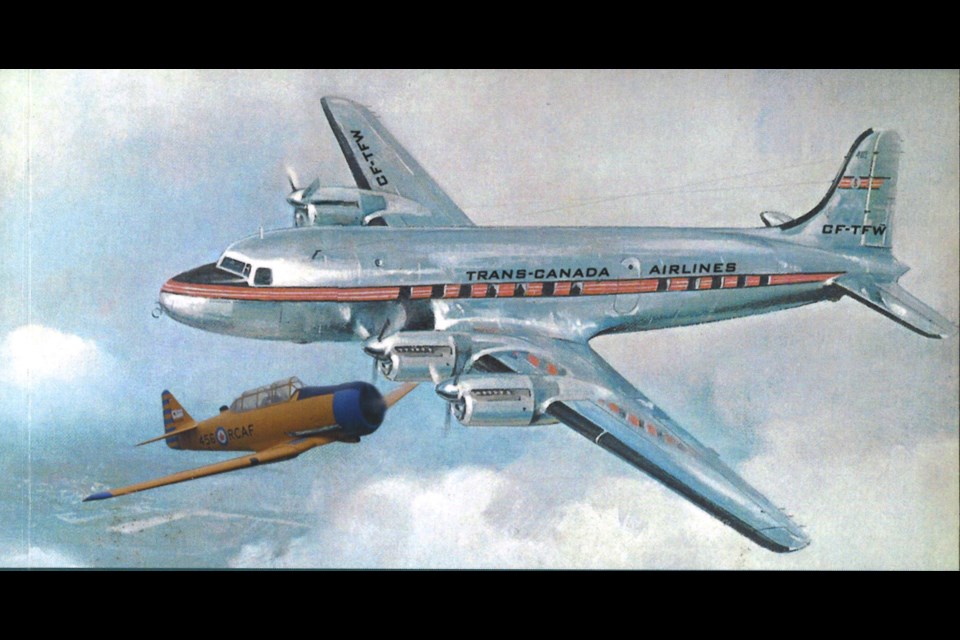MOOSEJAWTODAY — “As the dawn broke over Moose Jaw, Saskatchewan, on 8 April 1954, the clear and bright morning seemed to usher in a lovely spring day.
“Children went off to school while toddlers stayed home to play in the yard. Breadwinners went off to work as mothers tackled the laundry or hustled off to appointments and other commitments. People went about their normal lives, thinking nothing was out of the ordinary as Harvard trainer engines could be heard above, flying from the Royal Canadian Air Force (RCAF) school located four miles south of the city.
“The day had begun as any other day for the prairie down of 27,000 people, peaceful and uneventful. Little did anyone suspect that by 10:03 a.m. local time,
“The 8th of April would be unlike any other day as people on the ground watched helplessly as a Trans Canada Airlines (TCA) North Star passenger liner and an RCAF Harvard Mark II trainer collided and fell to the city below.”
So begins an essay that researcher Rachel Lea Heide wrote in 2003 about civil-military relations before, during and after the mid-air collision that occurred on that fateful day 70 years ago.
Her paper summarizes the catastrophic incident and the investigations that occurred afterward into what happened and how the collision occurred. Despite three thorough and detailed investigations, officials couldn’t determine who was truly responsible for the accident.
The essay’s introduction helps kick off this series, which takes a deeper look at the mid-air collision using archival material from various sources.
Like a falling leaf
TCA Flight 9-7 — originating in Montreal — was 7.5 hours behind schedule, as bad weather and high winds had grounded the Vancouver-based flight in Winnipeg, Heide wrote. Instead of passing over Moose Jaw at night, the North Star arrived in broad daylight just as airbase training was picking up momentum.
Harvard 3309 took off at 9:57 a.m. for a cross-country, solo navigation exercise that would take the pilot trainee from Moose Jaw to Raymore, then Hanley and Beechy, and back to Moose Jaw.
“Being Thursday, aircraft were to take off using a right-hand circuit. Flying in this direction made it very easy to pass over Moose Jaw by mistake before corrective action could be taken to set the plane on course again,” the essay said.
Acting Pilot Officer Thomas Andrew Thorrat’s flight over Moose Jaw contravened local flying orders for No. 2 flight training school, which forbid air force planes from flying over the city. Yet, hearing Harvard engines and seeing yellow planes overhead were not unusual for residents.
Normally, TCA planes flew at 10,000 feet, although the planned altitude over Saskatchewan for TCA Flight 9-7 was 4,000 feet. Meanwhile, the Harvard was expected to reach heights of 7,500 to 9,000 feet; however, it, too flew at 4,000 feet.
“Many witnesses to the crash thought at first that the Harvard was flying higher than the North Star, and they assumed — or rather hoped — that the trainer would fly safely over the passenger liner … ,” Heide wrote.
“The inconceivable occurred before the very eyes of stunned viewers below. The Harvard’s nose and engine struck the North Star behind one of the port engines, and almost simultaneously, the starboard wing of the Harvard collided with the port wing of the North Start,” she continued.
The Harvard’s momentum kept it moving and it plowed into the North Star’s fuselage at the cabin door and sheered off the tail. Two explosions occurred, but the second one caused the TCA plane to spiral downward into the northeast neighbourhoods.
Worst air disaster in history
The mid-air collision became Canada’s worst air disaster to that point.
The passenger plane’s fuselage struck Gordon Hume’s home at 1324 Third Avenue Northeast, setting the residence on fire, demolishing it, and killing housecleaner Martha Hadwen.
Luckily, Mrs. Betty Hume had left 20 minutes earlier with her children for an appointment while Mr. Hume was working. However, the crash left the family homeless.
The fire spread to two nearby homes, which belonged to Dr. Leith Yonge, a psychiatrist in the health region, and Murray Brown, city editor for the Times-Herald. The flames heavily damaged the Yonge home, while they scorched the exterior of Brown’s home and caused smoke damage inside.
While the inside of Yonge’s house was ruined, neighbours saved his furniture.
Mrs. Brown was at home and told the Times-Herald that she thought the world had come to an end. Her son, Ross, attended the nearby Ross School and said he saw the accident through his classroom window.
School was out — almost forever
At that school, “(the) children were wonderful. They were completely poised and calm throughout,” principal Nan Bowring told the newspaper. There were roughly 350 pupils inside when the TCA airline plunged to the ground roughly 100 metres away.
“The children set a wonderful example for any group of adults under such circumstances,” she continued.
Bowring was giving an exam to her Grade 8 students when they heard an explosion following the collision, which occurred over a nearby golf course; she thought the school’s oil furnace had exploded in the basement. Meanwhile, the students could see debris hurling through the air through their windows.
The crippled airliner, “in a dizzy flat spin,” cleared the school before “crumpling onto a house like a great blow torch,” the article said.
The children were aware of the situation’s seriousness but stayed inside until noon while the principal cancelled the school’s morning recess. Teachers also forbade their students from going near the wreck at lunch, although they walked their charges home and helped them avoid the hundreds of cars that had descended on the crash site.
“The commendable attitude of the children was further exemplified by the fact that in the afternoon, there was almost 100 per cent attendance,” Bowring added.
Editor’s note: The information for this series came from the Moose Jaw Public Library archives, the Moose Jaw Museum and Art Gallery, and EphemeralTreasures.net.




